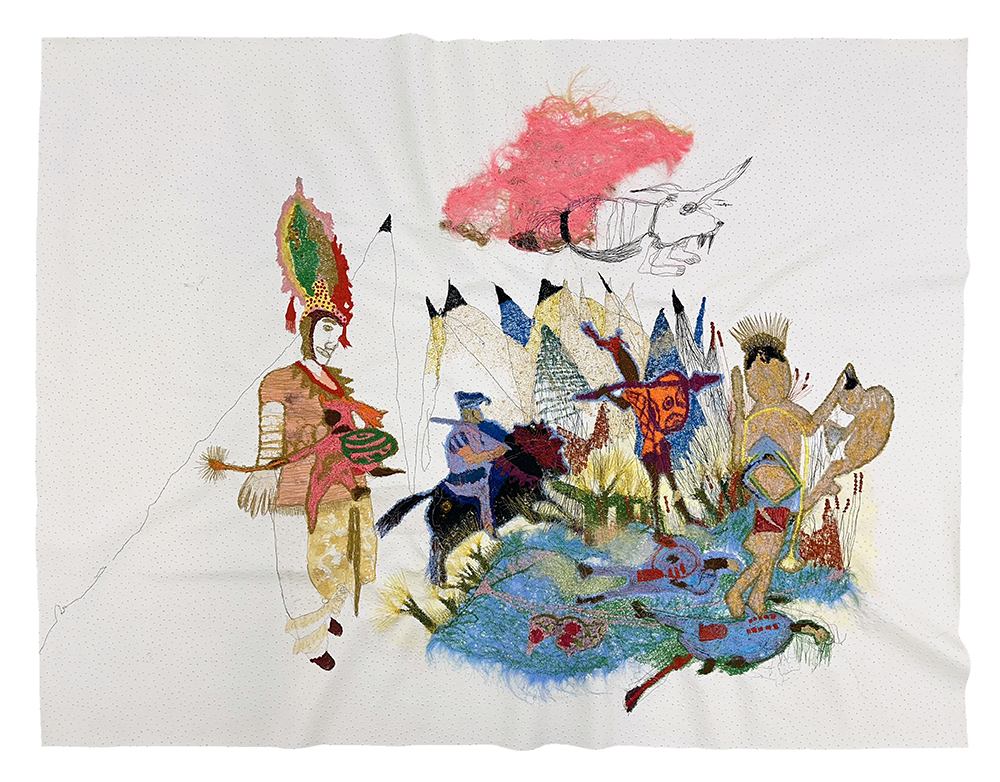The title of Griselda Rosas’ exhibition, “Donde pasó antes (Where it happened before),” recalls the classic fairy tale preamble, “Once upon a time…,” but also suggests a cautionary sense of place, a reference to location that doesn’t frame so much as foreground the action depicted there. Which is slightly ironic because the works Rosas has created here—in watercolor, embroidery, collage and other materials—are vessels for a volatile chemistry of color and texture that variously congeal, smolder and sublimate into a nebulous array of babies, battles, conquistadors, vortexes, regalia, insignia, animals and tissues. Alive, or in some transitional necrosis, they remain highly resistant to the perspective offered by narrative. They come at us like fluorescent fever dreams in bubbles, balloons or thought clouds—all but exploding as if from some alchemical retort.
Consider one of the first works encountered in this exhibition, La Batalla de Vortex (2024), in which pins or arrows seem to fly toward a vortex of escalating violence—with a hapless goat or ram set upon both by hunters outside the frame and a well-muscled cougar intent upon making this blood feast (rendered in dense velvety red dispersed into a skein of cross-stitching) its own. But who is in the eye of this vortex? The predator is itself subjected to these arrows. And what of a camouflage-like patch of green, right of center, (with fringed “mane”) overlapping a tessellated swag of petaled fans—greensward or devouring reptile? An incident on the verge of self-immolation—or simply decomposition? (Rosas pricks out the decay in decadence.) Or just a dream evaporating—like that rosy aura effervescing off the pale-blue peak of this food chain of fancy?

Griselda Rosas, Untitled (Coyote), 2023. Courtesy of the artist and Luis De Jesus Los Angeles.
Rosas uses embroideries not merely as embellishment, or as an alternative to pigments or graphic crosshatching, but almost as if she were devising new life forms—lacy passages like lichens. (A separate series of cyanotypes with collage are actually subtitled “Tejido Vivo,” translated as “living tissue.”) The works have a way of evolving before the viewer’s eyes. However simple the arrangement of figure, pattern, or incident, its narrative content is always mutable, transitory. Rosas is fascinated with pattern—the way we use it to shape, order, subdivide and punctuate. It might almost be argued that the “insignias” of Artifice de insignias reales 7 (Faux regalia 7) (2023) are the patterned sections that seem to demarcate or vectorially direct the viewer’s eye. Yet why does that sienna head-blob float off to the side of our playing card Aztec queen? We are regaled and beguiled.
Other works give us a harlequinade of figures (which seem to borrow variously from Persian Mogul and Indian miniatures, ancient Chinese and Aztec figures, and cartoonists from Steig to Steinberg) traversing terra not-at-all firma in various states of blithe terror or delight—some of them quite explicitly monstrous (e.g., a densely woven pink and blue-laddered SuperPerroMonstruo! (2023)). In works that almost defy categorization, Rosas seems intent on showing us that you can go a long way without really going anywhere. As Goya captioned one of his Caprichos “The Sleep of reason produces monsters,” what plays through these pieces is a sense that reason may as easily enable them.


